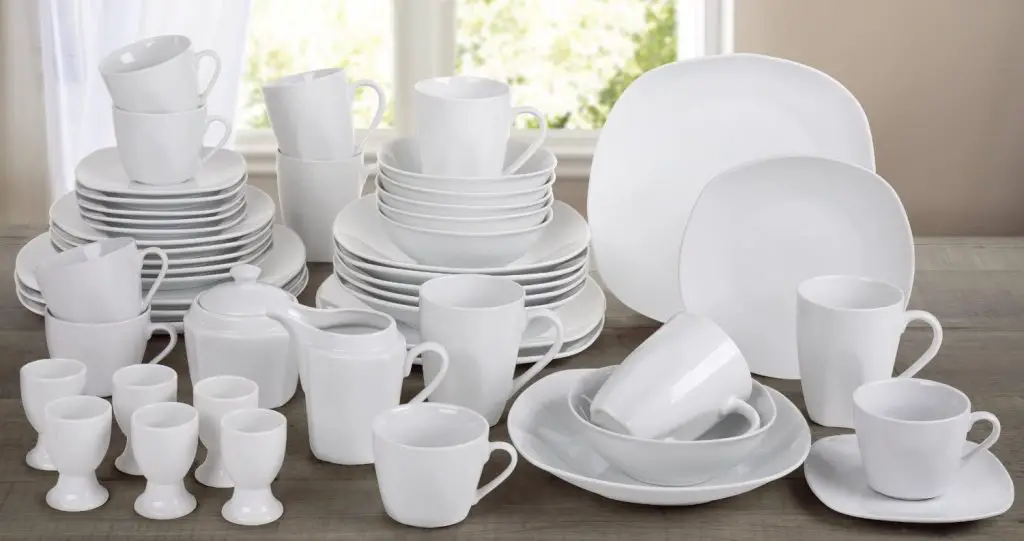China is a term used for crockery whether bone china (expensive and fine), earthenware (opaque and cheaper) or vitrified (metallized). Most catering crockery used nowadays tends to be vitrified earthenware, which is very durable and haven been strengthened. Chinaware is made of silica, soda ash, and china clay, glazed to give a fine finish. Chinaware is more resistant to heat than glassware and can be found in different colors and designs which are always coated with glaze.
There are many classification of catering china they are:
·
Bone china: Bone china is porcelain made of clay mixed with bone ash.
This is very fine, hard china that is very expensive. The decorations
are to be found under the glaze only. The price of bone china puts it
out of reach of the majority of everyday caterers, and only a few of the
top class hotels and restaurants would use it. The range of design,
pattern and color is very wide and there is something to suit all
occasions and situations.
· Porcelain: Porcelain is a ceramic
material made by heating selected and refined materials, which often
includes clay of kaolinite clay, to high temperatures. The raw materials
for porcelain, when mixed with water, form a plastic body that can be
worked to a required shape before firing in a kiln at temperatures
between 1200°C and 1400°C. The toughness, strength, and translucence of
porcelain arise mainly from the formation of glass at high temperatures
and the mineral malate within the fired body.
· Earthenware:
Earthenware may sometimes be as thin as bone china and other porcelains,
though it is not translucent and is more easily chipped. Earthenware is
also less strong, less tough, and more porous than stoneware, but its
low cost and easier working compensate for these deficiencies. Due to
its higher porosity, earthenware must usually be glazed in order to be
watertight.
· Stoneware: Stoneware is a hard pottery made from
siliceous paste fired at high temperature to vitrify (make glassy) the
body. Stoneware is heavier and more opaque than porcelain. The usual
color of fired stoneware tends to be grayish, though there may be a wide
range of colors, depending on the clay. It has been produced in China
since ancient times and is the forerunner of Chinese porcelain.
Different types of crockery and their sizes
| S.no | Name of Crockery | Size | Uses | Notes |
| 1 | Quarter Plate | 6’’(15cm diameter | Used to keep bread, cheese or as an underliner | It is also known as B&B Plate (bread & butter, under plate, side Plate |
| 2 | Half Plate | 8’’ (20 cm diameter) | Used to serve starters, pasta, dessert, fish etc | It is also known as dessert plate, fish plate |
| 3 | Full Plate | 10’’ (25cm diameter) | Used to serve main course | It is also known as dinner plate, joint plate, meat plate. |
| 4 | Soup bowl | 250ml | Used to serve soup, breakfast cereals | |
| 5 | Soup cup | 250ml | Used to serve thin soup | It is also known as consommé cup and has two handles. |
| 6 | Soup Plate | 8’’ (20 cm diameter) | Used to serve both thick and thin soup | Half plate is used as an underliner. It is not in use nowadays. |
| 7 | Breakfast cup | 240-300 ml (8-10 Fl oz) | Used to serve all Tea and coffee during breakfast | |
| 8 | Tea Cup | 200 ml (62/3Fl oz) | Used to serve tea during the day | |
| 9 | Coffee cup | 97-100 ml | Used to serve coffee after lunch or dinner | It is also known as demi-tasse. |
| Other china ware are | ||||
| 1 | Salad cresent | |||
| 2 | Egg cup | |||
| 3 | Ashtray | |||
| 4 | Creamer | |||
| 5 | Coffee / tea pot | |||
| 6 | Sugar basin | |||
| 7 | Milk jug |
